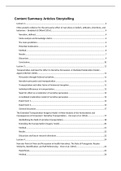Content Summary Articles Storytelling
Lecture 2.............................................................................................................................................4
Meta-analytic evidence for the persuasive effect of narratives on beliefs, attitudes, intentions, and
behaviors – Braddock & Dillard (2016)...............................................................................................4
Narrative, defined...........................................................................................................................4
Meta-analysis and knowledge claims.............................................................................................4
The main prediction........................................................................................................................4
Potential moderators......................................................................................................................5
Method...........................................................................................................................................6
Results............................................................................................................................................7
Discussion.......................................................................................................................................9
Conclusions...................................................................................................................................10
Lecture 3...........................................................................................................................................11
Transportation and Need for Affect in Narrative Persuasion: A Mediated Moderation Model –
Appel & Richter (2010).....................................................................................................................11
Persuasion through fictional narratives........................................................................................11
Narrative persuasion and transportation.....................................................................................11
Transportation and other forms of immersed reception..............................................................11
Individual differences in transportation.......................................................................................12
Need for affect as a moderator of narrative persuasion...............................................................12
A mediated moderation model of narrative persuasion...............................................................12
Experiment 1................................................................................................................................14
Experiment 2................................................................................................................................15
General discussion........................................................................................................................17
The Extended Transportation-Imagery Model: A Meta-Analysis of the Antecedents and
Consequences of Consumers’ Narrative Transportation – Van Laer et al. (2014)............................17
(Re)Defining the field of narrative transportation........................................................................18
Extending the transportation-imagery model..............................................................................20
Method.........................................................................................................................................21
Results..........................................................................................................................................22
Discussion and future research directions....................................................................................22
Lecture 4...........................................................................................................................................24
Narrator Point of View and Persuasion in Health Narratives: The Role of Protagonist–Reader
Similarity, Identification, and Self-Referencing – Chen et al. (2016).................................................24
Hypotheses...................................................................................................................................24
Method.........................................................................................................................................26
, Results..........................................................................................................................................26
Discussion.....................................................................................................................................27
Do ads that tell a story always perform better? The role of character identification and character
type in storytelling ads – Dessart (2018)..........................................................................................28
Introduction..................................................................................................................................28
Storytelling advertising and narrative transportation...................................................................29
Characters in stories: the role of identification and character types............................................29
Study 1..........................................................................................................................................30
Study 2..........................................................................................................................................31
Study 3..........................................................................................................................................32
Study 4..........................................................................................................................................33
General discussion........................................................................................................................35
Lecture 5...........................................................................................................................................36
Self-Referencing and Persuasion: Narrative Transportation versus Analytical Elaboration – Edson
Escalas (2007)...................................................................................................................................36
Self-referent processing................................................................................................................36
Narrative self-referencing.............................................................................................................36
The development of the hypotheses............................................................................................36
Experiment 1................................................................................................................................37
Experiment 2................................................................................................................................38
Conclusion....................................................................................................................................40
The role of prior attitudes in narrative persuasion: Evidence from a cross-national study in
Germany and the United States – Oschatz et al. (2021)...................................................................40
Mechanisms of narrative persuasion............................................................................................41
The role of prior attitudes in narrative persuasion.......................................................................41
Method.........................................................................................................................................42
Results..........................................................................................................................................42
Discussion.....................................................................................................................................43
Lecture 7...........................................................................................................................................45
Narratives are Persuasive Because They are Easier to Understand: Examining Processing Fluency as
a Mechanism of Narrative Persuasion – Bullock et al. (2021)...........................................................45
Introduction..................................................................................................................................45
Materials and methods.................................................................................................................47
Results..........................................................................................................................................47
Discussion.....................................................................................................................................48
Metacognitive approach to narrative persuasion: the desirable and undesirable consequences of
narrative disfluency – Walter et al. (2021).......................................................................................49
, Narrative persuasion and preexisting attitudes............................................................................49
The potential benefits of narrative disfluency..............................................................................50
Overview of current studies.........................................................................................................50
Study 1..........................................................................................................................................51
Study 2..........................................................................................................................................53
General discussion........................................................................................................................55
Lecture 8...........................................................................................................................................56
Stylistic Features, Need for Sensation, and Confirmed Recall of National Smoking Prevention
Advertisements – Niederdeppe et al. (2007)....................................................................................56
The activation model of information exposure.............................................................................56
The limited capacity model of mediated message processing......................................................56
Study overview and hypotheses...................................................................................................57
Methods.......................................................................................................................................58
Results..........................................................................................................................................58
Discussion.....................................................................................................................................59
Each Medium Tells a Different Story: The Effect of Message Channel on Narrative Persuasion –
Walter et al. (2017)...........................................................................................................................60
Transportation..............................................................................................................................60
Reactance.....................................................................................................................................61
Method.........................................................................................................................................61
Results..........................................................................................................................................62
Discussion.....................................................................................................................................62
Lecture 9...........................................................................................................................................63
An ‘‘Empathy Machine’’ or a ‘‘Just-for-the-Fun-of-It’’ Machine? Effects of Immersion in Nonfiction
360-Video Stories on Empathy and Enjoyment – Barreda-Ángeles et al. (2020)..............................63
Introduction..................................................................................................................................63
Method.........................................................................................................................................64
Results..........................................................................................................................................64
Discussion.....................................................................................................................................65
Cinematic Narration in VR – Rethinking Film Conventions for 360 Degrees – Gödde et al. (2018). .65
Introduction..................................................................................................................................65
Theoretical Background and Related Work..................................................................................66
Guidelines for Cinematic Narration in VR.....................................................................................66
User Study....................................................................................................................................68
Conclusion....................................................................................................................................70
, Lecture 2
Meta-analytic evidence for the persuasive effect of narratives on
beliefs, attitudes, intentions, and behaviors – Braddock & Dillard
(2016)
Loosely speaking, a message may be called a narrative if it is a story that contains information about
setting, characters, and their motivations.
There are many possible reasons for the burgeoning interest in narrative, one of which is the
belief that stories can be an especially potent means of creating opinion change. Narratives have
been implicated in support for controversial political policies (Iguarta, 2010), the end of slavery
(Strange, 2002), improved health (Hinyard & Kreuter, 2007), and recruitment into terrorist groups
(Casebeer & Russell, 2005). Other studies, however, report that narrative has little or no effect on
these (or other) outcomes (e.g., Cheney, Kohler, & Muilenburg, 2006; Prati, Pietrantoni, & Zani,
2012), or that it produces effects contrary to those advocated (e.g., Gesser-Edelsburg & Endevelt,
2011).
Narrative, defined
Any definition should support that narratives are about
problem solving,
conflict,
interpersonal relations,
human experience, and
the temporality of existence.
Using these basic features as a guide,
Ryan (2007) developed a “toolkit” for
defining narrative. Specifically, she
argued that the degree to which a
message can be called a narrative is
based on eight propositions (p. 29):
Together, these eight conditions allow scholars to compose their own definitions for narrative
based on their research objectives. From this toolkit, we propose that a narrative is a cohesive,
causally linked sequence of events that takes place in a dynamic world subject to conflict,
transformation, and resolution through non-habitual, purposeful actions performed by characters.
Meta-analysis and knowledge claims
The quantitative summary of primary studies (i.e., meta-analysis) can be expected to yield two types
of knowledge claims (Dillard, 1998): relationship-present and relationship absent claims.
Relationship-present claims assert the existence of some association between X and Y.
A second sort of knowledge claim relates to the lack of association between two variables.
These have been termed relationship-absent claims because they assert the absence of an
association between X and Y.
The main prediction
Moyer-Gusé (2008) suggests that narrative may persuade by reducing reactance, counter arguing, or
selective avoidance; increasing perceived vulnerability or self-efficacy; and/or changing perceived
norms or outcome expectancies.
Given the many theoretical arguments for the persuasive effectiveness of narrative, the
primary goal of this project was to synthesize the literature related to narrative’s effect on four key
indices of persuasion: changes in beliefs, attitudes, intentions, and behavior.





